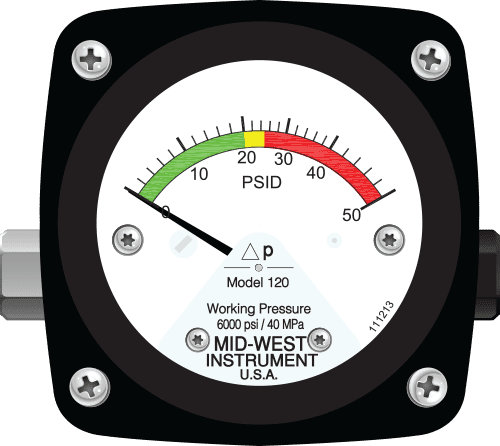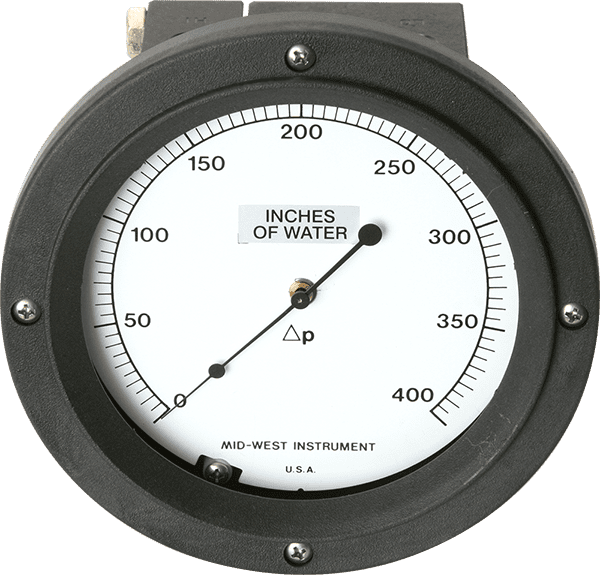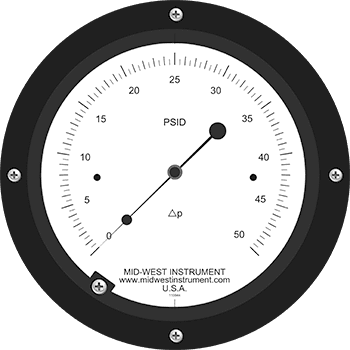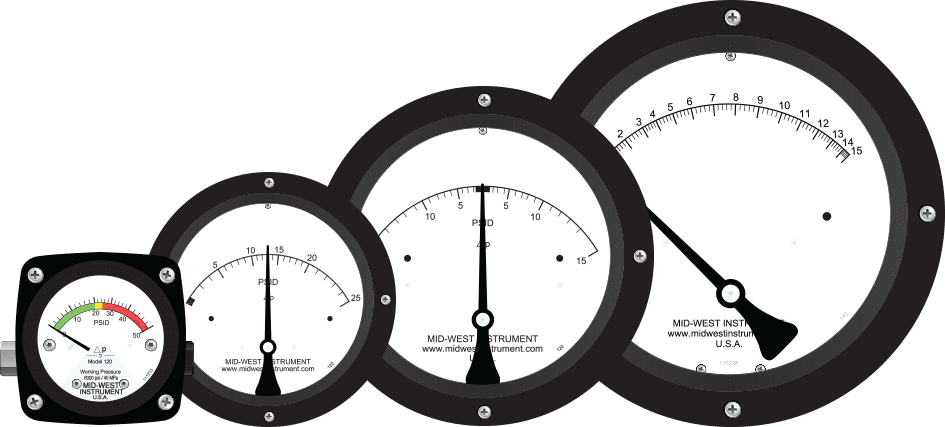Piston Type Gauge

Piston type: ± 2% or ± 5% Full Scale Accuracy. These kinds of differential pressure sensor applications are primarily designed for liquid applications. They exhibit a slight amount of bypass as the fluid crosses from the high to the low pressure port. The crossover is often deemed too great for the application because gas molecules are smaller. The Differential Pressure is sensed by the movement of a precisely ground floating piston/magnet in a precision bore against a calibrated spring. Any variation in pressure on either side of the piston/magnet will cause the magnet to move proportionally to the change in differential pressure. A rotary pointer magnet located close to the internal magnet, but outside the pressure housing, follows the movement of the piston magnet and indicates differential pressure on the dial. Piston type DP gauges exhibit a slight amount of bypass as the fluid crosses from the high to the low pressure port. Due to precision sizing of piston and body bore, leakage across the piston will not exceed 15 SCFH air at 100 PSID at ambient conditions.
Piston-Type Differential Pressure Gauges are available with one or two hermetically sealed reed switches or 4-20mA transmitter depending on model. The switches are adjustable within a defined percentage of the full scale range of the gauge and are available in SPDT and SPST, normally open or normally closed configurations for various load/power ratings. The switches can be set to activate or deactivate on rising or falling pressure. Switches are “CE” marked per the EU low voltage directive. Models 120, 121, & 123 can be configured for use in hazardous locations. All hazardous location switches are both CSA and UL listed. The CSA & UL listings are for the entire assembly and not just the enclosure.
Piston Type Gauges
Diaphragm Type Gauge

Diaphragm type: ± 2% or ± 5% Full Scale Accuracy. The high and low-pressure ports are completely isolated from each other. There is no bypass and therefore they are ideally suited for use on dissimilar fluids, air, gases, or liquids with a high concentration of solids, etc. They also come in a variety of sizes allowing for very sensitive measurements. This differential pressure product senses differential pressure by the movement of an elastomer diaphragm against a precision calibrated range spring. The change in position of the diaphragm in response to the change in Differential Pressure moves an internal magnet. This magnet, in turn, causes a rotary magnet external to the gauge body to rotate. This rotary magnet has a pointer attached which indicates the differential pressure on the dial.
Diaphragm-type differential pressure sensor applications are available with one or two hermetically sealed reed switches or a 4-20mA transmitter model dependent. The switches are adjustable within a defined percentage of the full scale range of the gauge and are available in SPDT and SPST normally open configurations for various load/power ratings. The switches can be set to activate or deactivate on rising or falling pressure. Models 130, 140, 142, 522, & 522A Switches are “CE” marked per the EU Low Voltage and RoHS Directives.
The Model 700 series uses a piezo-resistive differential pressure sensor element. Silicone oil is filled between the die and 2 stainless steel diaphragms. The measured differential is amplified into a usable voltage or converted into a 4-20 ma output.
Hazardous location switches Models 140, and 142 are certified CSA and UL to Canadian & US Standards. Model 240 is CSA, UL Listed and CE marked to the ATEX directive and KOSHA certified along with the option for DPDT relays for higher load applications. The CSA & UL listings are for the entire assembly and not just the enclosure. See individual models for complete specifications.
Diaphragm Type Gauges
Bellows Type Gauge

Bellows type : – ± 1/2% or ± 1% Full Scale Accuracy. Differential pressure is applied to the bellows and mechanical linkage assembly. As pressure changes, the bellows and linkage assembly is mechanically coupled to the gauge indicator pointer. If equipped with a micro-switch, a cam mechanically linked to the bellows, rotates and triggers the micro-switch. The major components of the Model 105/106/115 and 116 are a two-piece body, bellows sensing element and over-pressure assembly, a torque tube assembly, a range spring, the gauge front assembly. Model 105/106/115 and 116116 assembly are protected against over-range in either direction to the rated working pressure by a bi-directional relief valve.
The body halves provide the pressure containment function. They also clamp the sensing element and over-pressure assembly between the halves, isolating the high side and low side pressures of the system. The high side body half also provides a mount for the torque tube assembly and the gauge front assembly.
The sensing element is exposed to the differential pressure and deflects in response to the differential pressure. This assembly incorporates a bidirectional relief valve which provides over-pressure protection in both directions. When over-pressured from the high side, the valve is opened by a mechanical stop as the sensing element deflects to its maximum travel. When over-pressured from the low side, the spring-loaded valve opens when the differential pressure exceeds its maximum rating.
The opening of the valve in either direction equalizes the pressure and protects the unit. A range spring is provided to adjust the spring rate of the system to suit the various differential pressure ranges of the instrument. NOTE: The use of diaphragm seals is not recommended for model 105/106/115/116 series gauge. Attempts to install such seals on these gauges will void the warranty.
Bellows Type Gauges
High Accuracy
Bourdon Tube Type Gauge

Bourdon Tube type – ± 1/2% or ± 1% Full Scale Accuracy. System pressure is applied to the inside of a slightly flattened arc- shaped tube. As pressure increases, the tube tends to restore to its original round cross-section. This change in cross-section causes the tube to straighten. Since the tube is permanently fastened at one end, the tip of the tube traces a curve that is the result of the change in angular position with respect to the center.
Mid-West Model 109 is powered by a test quality Bourdon Tube Assembly. The assembly is encapsulated in a high pressure chamber that is fitted with a pressure connection to the inside of the Bourdon Tube and a second connection to the pressure chamber. The Model 109 indicates the difference between the pressure applied inside the Bourdon Tube and the pressure inside the chamber.
The pressure chamber for the assembly is small, close fitting and rugged. The volume displacement of the Bourdon Tube through the pressure range is near to zero (0.02 c.c.). The speed of response of the indicator to changes in differential pressure is instantaneous, even on low volume pressure systems. The low volume displacement is an important advantage for differential pressure leak detection, and when isolation diaphragms are required.
The Bourdon Tube Assembly is protected against over-range in either direction to the rated working pressure by a bi-directional relief valve. The output shaft of the gauge assembly is magnetically coupled through the solid wall of the pressure chamber to a sensitive jeweled pointer shaft in the dial housing outside the chamber. The magnetic coupling transmits the exact motion of the assembly to the pointer to give an accurate dial reading of the differential pressure. NOTE: The use of diaphragm seals is not recommended for Model 109 series gauge. Attempts to install such seals on these gauges will void the warranty.
Bourdon Tube Type Gauges
High Accuracy






